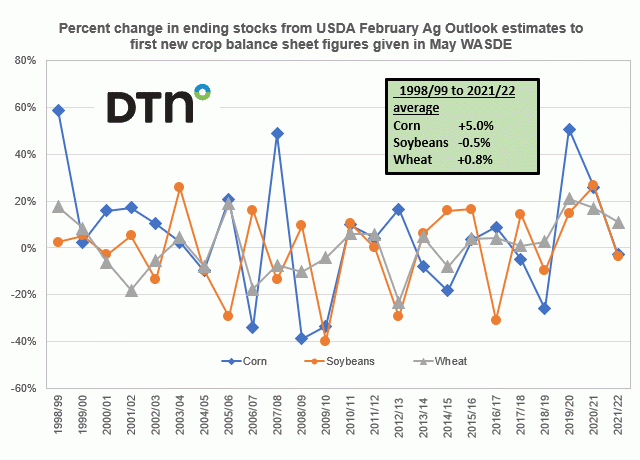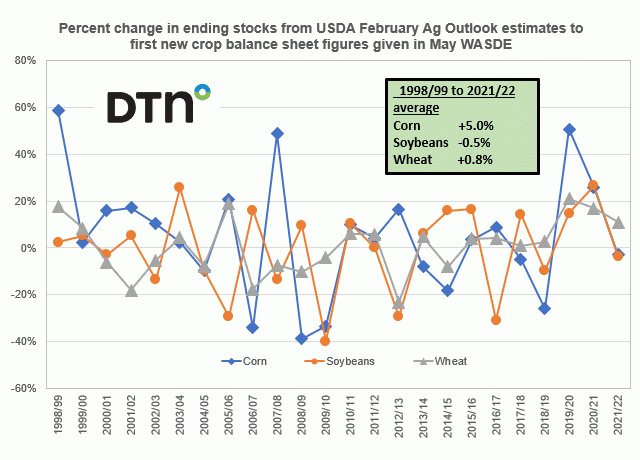Fundamentally Speaking
Changes to Ending Stocks for Major Crops
Price activity in the grain and oilseeds complex continues to be completely frenetic, unlike anything anyone involved in these commodities has ever seen.
Markets are trying to come to grips that the easy pushover Putin imagined is far from the case as he is doubling down in the face of huge world condemnation and now growing internal dissent in Russia itself.
More attention is being focused not only on what could be lost 2021 exports but the fate of Ukrainian and even Russian crops production for this year.
The better tone to South American weather, USDA reports, Fed interest policy and other key price drivers are all taking a far back seat to the conflict in Europe.
P[L1] D[0x0] M[300x250] OOP[F] ADUNIT[] T[]
It does appear that the greater impact on the U.S. balance sheets for the major crops could be seen for the upcoming season as the full extent of crop losses out of South America and the ramifications from the military conflict in the Black Sea area becomes clearer.
We took a look again at the USDA's grain and oilseeds outlook for 2022 given at their annual Outlook Forum meeting little more than two weeks ago and while the South American drought was noted in the soybean section, there was no mention of the Russian-Ukrainian situation within the presentation as war at that time it was hoped and perhaps considered to be a remote possibility.
Much has changed since then and while there was always going to be a lot of attention on the supply side of the equation given the huge acreage battle shaping up, the demand side of the ledger as it usually does would evolve over time.
Now with output and export availability of key crops out of Argentina, Brazil, Russia and Ukraine sharply reduced, the U.S. is one of the few regions of the world where some of this shortfall can be made up.
As result the 2022/23 U.S. corn, soybean and wheat ending stocks projections issued at their Outlook Forum could be vastly different when USDA issues its first WASDE report for the upcoming season in May.
This graphic shows the percent change in ending stocks from the USDA February Ag Outlook estimates to first new crop balance sheet figures given in May WASDE for corn, soybeans, and wheat.
The average change in about ten weeks between the Outlook Forum projections and the May WASDE report estimates is corn stocks coming in 5% greater in the WASDE vs. what USDA projected in February with bean stocks about 0.5% lower and wheat stocks 0.8% higher.
Corn changes also have the highest standard deviation showing more volatility between the two sets of projections and have seen some years where the corn carryout can be more than 50% greater than what USDA had estimated in February and some years where it is 30% lower.
What can trigger this sizable difference seems to be a much higher or lower plantings figure as given in the March intentions report than what USDA projected in February and/or a really big change in demand projections, almost always due to a higher or lower export outlook than expected ten weeks earlier.
We have no idea what will transpire over the next two months but quite likely USDA's May 2022 WASDE ending stock figures could be quite a bit less than the 1.965 billon bushel (bb) corn, 0.305 bb soybean, and 0.731 bb wheat stocks they projected back on February 24.
(c) Copyright 2022 DTN, LLC. All rights reserved.







Comments
To comment, please Log In or Join our Community .